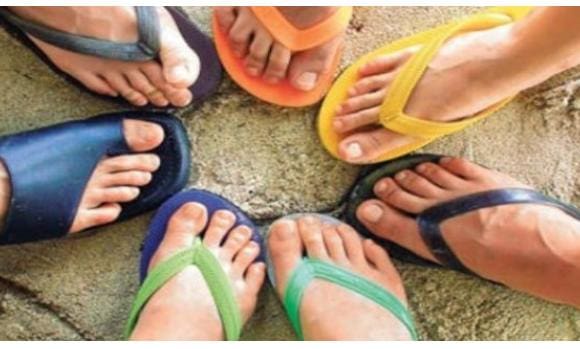Flip-flops are a type of open-toed footwear that consists of a flat sole held loosely on the foot by a Y-shaped strap, also known as a toe thong, that passes between the first (big) and second toes and around both sides of the foot. The name “flip-flop” comes from the sound the sandals make when they slap between the sole of the foot and the floor when walking.
They are called thongs in Australia, jandals (short for “Japanese sandals”) in New Zealand, slippers in Hawaii and the Caribbean, and other names in other locales. This footwear is popular in many parts of the world for its convenience, especially in warmer weather and beachside environments.
However, because they provide very little protection and support for the foot, they can lead to a range of potential foot health issues if worn excessively or for inappropriate activities. As such, their usage is generally recommended to be limited to short-term or less intensive activities.
Here are some of the issues associated with frequent flip-flop use:
- Lack of Support: Flip-flops typically lack the arch support that other types of shoes provide. This can lead to foot pain, especially for those with flat feet or high arches, and potentially lead to conditions like plantar fasciitis (inflammation of the tissue that connects your heel to your toes).
- Increased Risk of Injury: The open design of flip-flops leaves the foot vulnerable to injuries like cuts, scrapes, and bruises. The lack of ankle support can also increase the risk of sprains and fractures from trips or falls. Additionally, it’s easier for the foot to slide off the flip-flop, leading to potential injury.
- Foot Conditions: Overuse of flip-flops can lead to conditions like hammer toe or bunions, due to the way your toes grip the shoe to keep it in place. This can change the mechanics of how you walk and put stress on other parts of your body.
- Skin Problems: Flip-flops expose the foot to the elements, increasing the risk of sunburn, fungal infections, or warts. The strap between the toes can also cause irritation or blisters.
- Alteration of Gait: Wearing flip-flops alters your stride, and you may end up taking shorter steps, which can lead to discomfort and strain in the lower legs and feet.
- Poor Shock Absorption: Flip-flops provide minimal cushion for the feet while walking. This lack of shock absorption can lead to pain in the feet, legs, hips, or even the back after extended periods of wear.
- Posture Problems: Due to the lack of arch support and the altered gait that results from wearing flip-flops, prolonged use can lead to poor posture, potentially resulting in back, neck, or shoulder pain. When your feet are not adequately supported, it can affect the alignment of your entire body and over time, this can cause muscular imbalances or strain.
- Toe Deformities: As we discussed earlier, the grip required to hold flip-flops on your feet can lead to issues like hammertoes (where the toe is bent at the middle joint) and claw toes (where the toe curls down). Overuse of the flexor muscles (the ones that allow you to curl your toes) can lead to these deformities over time.
- Metatarsalgia: This is a condition characterized by pain and inflammation in the ball of the foot. It can be caused by wearing footwear, like flip-flops, that lack appropriate cushioning and support.
- Tendonitis: Wearing flip-flops may increase the risk of developing Achilles tendonitis. This condition is inflammation of the Achilles tendon, the band of tissue that connects the calf muscles at the back of the lower leg to your heel bone. Because flip-flops lack proper support, they can place added stress on this tendon.
- Exposure to Bacteria and Parasites: Given that flip-flops leave the foot almost entirely exposed, there is an increased risk of contracting bacterial or fungal infections, or even parasitic infections like hookworm, especially when worn in public areas or outdoors.
- Driving Hazard: Flip-flops can be a hazard when driving, as they can easily slip off and become wedged under the pedals.
It’s important to note that while flip-flops can be a convenient choice for beachwear or communal showers, they aren’t designed for prolonged use or walking long distances. Appropriate footwear can go a long way toward maintaining foot health, preventing injury, and preserving alignment and balance. As always, if you experience consistent discomfort or pain while wearing flip-flops, or any shoe, it is recommended that you consult a podiatrist or other healthcare professional.
When should I not use flip-flops?
While flip-flops are a popular choice for their convenience and comfort, especially during warmer weather, there are several situations where it’s advisable not to wear them due to the lack of support and protection they offer. These include:
- Long Walks or Hiking: Flip-flops don’t provide the necessary support or protection for longer walks or hikes. They can cause blisters, and the lack of support can lead to foot and leg pain.
- Driving: Flip-flops can slip off easily, potentially getting stuck under the pedals and interfering with safe driving.
- Gardening or Yard Work: When using tools or mowing the lawn, it’s essential to protect your feet. A sturdy pair of closed-toe shoes can prevent injuries from sharp tools or falling objects.
- Playing Sports or Running: Sports and running require footwear that provides proper support and protection to avoid injuries. Flip-flops don’t offer the necessary stability or shock absorption.
- Rainy Weather: Flip-flops can become slippery when wet, increasing the risk of slips and falls. They also offer no protection from puddles or wet surfaces.
- Construction Sites or Workshops: These places often have sharp objects, heavy tools or machinery that can cause serious foot injuries. Safety shoes or boots are a must in these environments.
- Cold Weather: Flip-flops expose a significant portion of the foot, which can lead to discomfort or even frostbite in cold weather.

